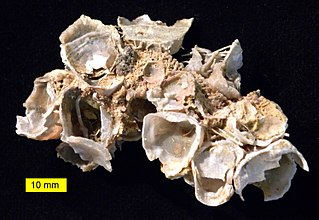Related Research Articles

In the geologic timescale, the Roadian is an age or stage of the Permian. It is the earliest or lower of three subdivisions of the Guadalupian epoch or series. The Roadian lasted between 272.95 and 268.8 million years ago (Ma). It was preceded by the Kungurian and followed by the Wordian.
In the geologic timescale, the Wordian is an age or stage of the Permian. It is the middle of three subdivisions of the Guadalupian epoch or series. The Wordian lasted between 268.8 and 265.1 million years ago (Ma). It was preceded by the Roadian and followed by the Capitanian.
In the geologic timescale, the Wuchiapingian or Wujiapingian is an age or stage of the Permian. It is also the lower or earlier of two subdivisions of the Lopingian epoch or series. The Wuchiapingian spans the time between 259.1 and 254.14 million years ago (Ma). It was preceded by the Capitanian and followed by the Changhsingian.
In the geologic time scale, the Changhsingian or Changxingian is the latest age or uppermost stage of the Permian. It is also the upper or latest of two subdivisions of the Lopingian epoch or series. The Changhsingian lasted from 254.14 to 251.902 million years ago (Ma). It was preceded by the Wuchiapingian and followed by the Induan.
The Visean, Viséan or Visian is an age in the ICS geologic timescale or a stage in the stratigraphic column. It is the second stage of the Mississippian, the lower subsystem of the Carboniferous. The Visean lasted from 346.7 to 330.9 Ma. It follows the Tournaisian age/stage and is followed by the Serpukhovian age/stage.
Hindeodus is an extinct genus of conodonts in the family Anchignathodontidae. The generic name Hindeodus is a tribute to George Jennings Hinde.
The Bayan Mandahu Formation is a geological unit of "redbeds" located near the village of Bayan Mandahu in Inner Mongolia, China Asia and dates from the late Cretaceous Period. Laid down in the Campanian, it is dated somewhat uncertainly to between 75-71 mya.
The Haifanggou Formation is a fossil-bearing rock deposit located near Daohugou village of Ningcheng County, in Inner Mongolia, northeastern China.
Daqingshanodon is an extinct genus of dicynodont therapsid from the Late Permian of Inner Mongolia, China. The type species D. limbus was described in 1989 from a single skull found in the Naobaogou Formation. Daqingshanodon belongs to a group of dicynodonts called cryptodonts. It is the smallest known cryptodont, and the only one known from China. Like other cryptodonts, it has a pair of rounded nasal bosses above its nostrils and a ridge of bone on the upper jaw called the postcaniniform process. Daqingshanodon has a pair of elongated, recurved tusks extending from its beak-like snout. It is distinguished from other dicynodonts by the presence of a distinct ridge running along the side of the skull from below the eye socket to the area around the tusks. The skull of Daqingshanodon is less than 10 centimetres (3.9 in) long, yet this specimen is thought to have been an adult on the basis of its well-developed nasal bosses.

Paleontology or palaeontology is the study of prehistoric life forms on Earth through the examination of plant and animal fossils. This includes the study of body fossils, tracks (ichnites), burrows, cast-off parts, fossilised feces (coprolites), palynomorphs and chemical residues. Because humans have encountered fossils for millennia, paleontology has a long history both before and after becoming formalized as a science. This article records significant discoveries and events related to paleontology that occurred or were published in the year 2013.
Hazhenia is an extinct genus of therocephalian therapsids from the Early Triassic of China, of which Hazhenia concava is the only species. Hazhenia was named in 1981 from the Heshanggou Formation in the Ordos Desert of Inner Mongolia. It lived during the Olenekian Age of the Early Triassic, about 247 million years ago. Hazhenia belongs to a group of therocephalians called Baurioidea and possesses many mammal-like features such as cusped teeth and a secondary palate, both of which evolved independently in baurioids. Within Baurioidea it is most closely related to the genus Ordosiodon, which is also known from Inner Mongolia but comes from the slightly younger Ermaying Formation. Both genera were once placed in the family Ordosiidae, but as the name is preoccupied by a family of Cambrian trilobites, it is no longer valid.

Jurassipanorpa is a genus of fossil scorpionfly containing two species described in 2014 from the Jiulongshan Formation of Inner Mongolia, China. The two species, J. impuctata and J. sticta, lived in the late Middle Jurassic period and represent the oldest known representatives of the scorpionfly family Panorpidae.
Sweetognathus is an extinct genus of conodonts in the family Sweetognathidae.
Vjalovognathus is an extinct genus of conodonts.
Mesogondolella is an extinct genus of conodonts.
Conodonts are an extinct class of animals whose feeding apparatuses called teeth or elements are common microfossils found in strata dating from the Stage 10 of the Furongian, the fourth and final series of the Cambrian, to the Rhaetian stage of the Late Triassic. These elements can be used alternatively to or in correlation with other types of fossils in the subfield of the stratigraphy named biostratigraphy.
Histiodella is an extinct genus of conodonts.
Bannykus is an alvarezsaur from the Early Cretaceous of the Bayin-Gobi Formation of Inner Mongolia, China. It includes one species, Bannykus wulatensis. It is large for an alvarezsaur, with an estimated weight of 24kg based on femoral circumference.

